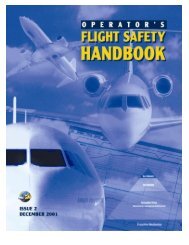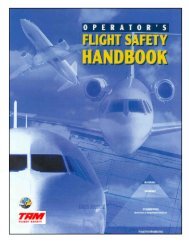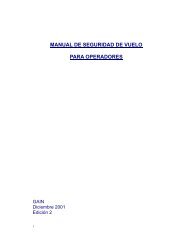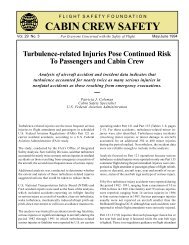Flight Safety Digest October 2005 - Flight Safety Foundation
Flight Safety Digest October 2005 - Flight Safety Foundation
Flight Safety Digest October 2005 - Flight Safety Foundation
Create successful ePaper yourself
Turn your PDF publications into a flip-book with our unique Google optimized e-Paper software.
10<br />
C ONVERSATION ANALYSIS<br />
However, Nevile (2004a, <strong>2005</strong>a) has found it to<br />
be unusual for fl ight crews to overlap their talk.<br />
That is, pilots usually do not begin talking when<br />
another pilot is still talking. This was seen to be the<br />
case even when pilots were talking and exchanging<br />
turns very quickly — for example, during the<br />
performance of a checklist.<br />
Pilots seem oriented to allow one another’s talk<br />
to emerge in the clear. Overlapping talk does<br />
occasionally occur, but relatively rarely in taskoriented<br />
talk.<br />
In the CVR data for the accident fl ight, there<br />
were more than 20 instances of overlapping<br />
talk. On its own, this is a noticeable feature of<br />
the accident fl ight. The great majority of these<br />
instances of overlapping talk occurred when the<br />
PIC began to talk when the copilot was already<br />
talking. That is, the PIC was the participant<br />
responsible for initiating the overlapping talk.<br />
Many of these instances were at points in the<br />
copilot’s talk where the PIC could expect that<br />
the copilot’s turn was coming to a close. That is,<br />
the PIC was predicting or projecting the end of<br />
the copilot’s turn and beginning his own turn<br />
at talk in response (see Example 3 and Example<br />
4). As we have said, this kind of overlap is common<br />
in everyday conversation but is uncommon<br />
in cockpit communication. Overlapped talk is<br />
shown by [square brackets].<br />
Example 3<br />
(10.1)<br />
PIC now the minute we go over Spring Hi:ll, (0.6)<br />
or whatever it’s called Simp- err=<br />
CP =Simpsons [ga:p<br />
PIC [Simpson is it?<br />
(0.2)<br />
PIC yea:h.<br />
(1.4)<br />
Example 4<br />
(2.2)<br />
CP gear’s down (.) three greens co[nfi rm?<br />
PIC [c:o:::nfi ::rm.<br />
(4.3)<br />
CP okay hydraulic pressure’s checked in two:::,<br />
anti[skid,<br />
[((tone, 1 second))<br />
PIC one to run.<br />
(0.4)<br />
More signifi cantly, however, there were also numerous<br />
instances in the data where the PIC began to talk<br />
even though the copilot had not fi nished his turn at<br />
talk, where there was potentially still talk of substance<br />
to be uttered and heard (see Example 5, Example 6 and<br />
Example 7). In lay terms, the PIC could be heard as<br />
interrupting the copilot. This occurred even at times<br />
when the copilot was presenting important information<br />
for the pilots’ joint conduct and understanding<br />
of the progress of the fl ight.<br />
Example 5<br />
(1.1)<br />
CP >Alice on< number one,<br />
(1.0)<br />
PIC ye::p.<br />
(0.4)<br />
PIC Alice on number one,<br />
(0.5)<br />
CP? (yep).<br />
(2.6)<br />
CP Simpson’s gap? (.) o:n [(0.2) number two,]<br />
PIC [Simpson’s gap’s] on<br />
number two::,<br />
(0.7)<br />
Example 6<br />
(0.4)<br />
CP thrust rever[sers check(ed).]<br />
PIC [(it’s on) light’s] out.<br />
(1.0)<br />
Example 7<br />
(1.5)<br />
CP below the: (.) lowest safe so, (0.5) twentynine<br />
(here) [(on the) ( )]<br />
PIC [(twentynine)]<br />
fi ve and eight (two)<br />
( )<br />
(3.5)<br />
These instances of overlapping talk suggest, at the<br />
very least, that these two pilots are not coordinating<br />
the timing of their communicative contributions<br />
in the smooth manner found to be typical of<br />
commercial fl ight crews. However, where one pilot<br />
initiated such points of overlapping talk far more<br />
than the other pilot, that pilot could be heard to be<br />
dominating the other pilot’s communication, and<br />
so also their contributions to the work of operating<br />
the aircraft. Overlapping talk is also possibly<br />
a problem because it can increase the chances of<br />
something being misheard, or not heard at all. The<br />
FLIGHT SAFETY FOUNDATION FLIGHT SAFETY DIGEST OCTOBER <strong>2005</strong>




![Download this Issue [PDF 7 MB] - Flight Safety Foundation](https://img.yumpu.com/18859635/1/190x245/download-this-issue-pdf-7-mb-flight-safety-foundation.jpg?quality=85)
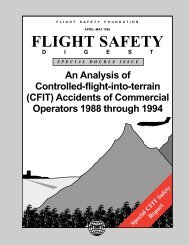
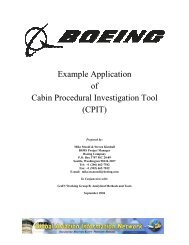
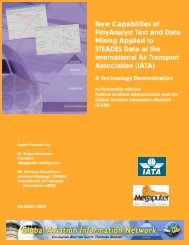
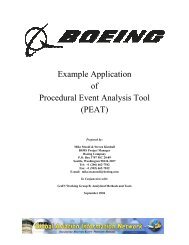
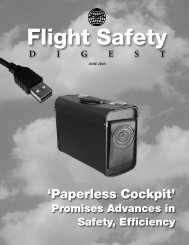
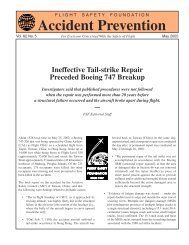
![Download [PDF 8 MB] - Flight Safety Foundation](https://img.yumpu.com/18859366/1/190x245/download-pdf-8-mb-flight-safety-foundation.jpg?quality=85)
